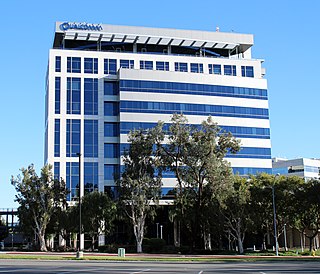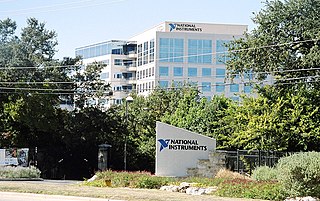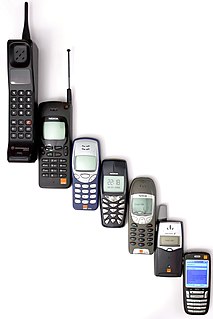
Qualcomm Incorporated is an American multinational semiconductor and telecommunications equipment company that designs and markets wireless telecommunications products and services. It derives most of its revenue from chipmaking and the bulk of its profit from patent licensing businesses. The company headquarter is located in San Diego, California, United States, and has 224 worldwide locations. The parent company is Qualcomm Incorporated (Qualcomm), which has a number of wholly owned subsidiaries: Qualcomm CDMA Technologies (QCT) sells all of Qualcomm’s products and services ; Qualcomm Technology Licensing (QTL) is responsible for the patent licensing business; and Qualcomm Technologies, Inc. (QTI) operates nearly all of Qualcomm's R&D activities.
Founded in 1969, Software AG is an enterprise software company with over 10,000 enterprise customers in over 70 countries. The company is the second largest software vendor in Germany, and the seventh largest in Europe. Software AG is traded on the Frankfurt Stock Exchange under the symbol “SOW” and part of the technology index TecDAX.

National Instruments Corporation, or NI, is an American multinational company with international operation. Headquartered in Austin, Texas, it is a producer of automated test equipment and virtual instrumentation software. Common applications include data acquisition, instrument control and machine vision.
System testing is testing conducted on a complete integrated system to evaluate the system's compliance with its specified requirements.
Mobile app development is the act or process by which a mobile app is developed for mobile devices, such as personal digital assistants, enterprise digital assistants or mobile phones. These applications can be pre-installed on phones during manufacturing platforms, or delivered as web applications using server-side or client-side processing to provide an "application-like" experience within a Web browser. Application software developers also must consider a long array of screen sizes, hardware specifications, and configurations because of intense competition in mobile software and changes within each of the platforms. Mobile app development has been steadily growing, in revenues and jobs created. A 2013 analyst report estimates there are 529,000 direct app economy jobs within the EU 28 members, 60% of which are mobile app developers.

Neopost is a global technology provider of digital communications, shipping and mail solutions. Neopost provides products ranging from physical mail processing systems to digital communications management, as well as supply chain and e-commerce process optimization solutions, from point of sale to delivery, including associated tracking services.
Communications servers are open, standards-based computing systems that operate as a carrier-grade common platform for a wide range of communications applications and allow equipment providers to add value at many levels of the system architecture.
Unified communications (UC) is a business and marketing concept describing the integration of enterprise communication services such as instant messaging (chat), presence information, voice, mobility features, audio, web & video conferencing, fixed-mobile convergence (FMC), desktop sharing, data sharing, call control and speech recognition with non-real-time communication services such as unified messaging. UC is not necessarily a single product, but a set of products that provides a consistent unified user interface and user experience across multiple devices and media types.
AWR Corporation is an electronic design automation (EDA) software company, formerly known as Applied Wave Research, and then acquired by National Instruments
Trillium Digital Systems developed and licensed standards-based communications source code software to telecommunications equipment manufacturers for the wireless, broadband, Internet and telephone network infrastructure. Trillium was an early company to license source code. The Trillium Digital Systems business entity no longer exists, but the Trillium communications software is still developed and licensed. Trillium software is used in the network infrastructure as well as associated service platforms, clients and devices.
Rohde & Schwarz GmbH & Co KG is an international electronics group specialized in the fields of electronic test equipment, broadcast & media, cybersecurity, radiomonitoring and radiolocation, and radiocommunication. The company provides products for the wireless communications, broadcast & media, cybersecurity and electronics industry, aerospace and defense, homeland security and critical infrastructures. It was founded in 1933.
Founded in 1998, Continuous Computing is a privately held company based in San Diego that provides telecom systems made up of telecom platforms and Trillium software, including protocol software stacks for femtocells and 4G wireless / Long Term Evolution (LTE). The company also sells standalone Trillium software products and ATCA hardware components, as well as professional services. Continuous Computing’s Trillium software addresses LTE Femtocells and pico / macro eNodeBs, as well as the Evolved Packet Core (EPC), Mobility Management Entity (MME), Serving Gateway (SWG) and Evolved Packet Data Gateway (ePDG).
MEDUSA, is a CAD program used in the areas of mechanical and plant engineering by manufacturers and Engineering, Procurement and Construction (EPC) companies. The system's history is closely tied to the beginnings of mainstream CAD and the research culture fostered by Cambridge University and the UK government as well as the resulting transformation of Cambridge into a world-class tech centre in the 1980s.

MAHLE Powertrain Ltd is the wholly owned engineering services division of MAHLE GmbH. With its headquarters in Northampton, UK and sister company in Plymouth, Michigan, United States the company specialises in the design, development and testing of internal combustion engines and provides a broad spectrum of engineering services to its global customer base. MAHLE Powertrain’s engineers and technical specialists are also present in the MAHLE research and development centres in Munich, Germany, São Paulo, Brazil and Shanghai, People's Republic of China.
Corelis, Inc, a subsidiary of Electronic Warfare Associates, Inc., is a private US company categorized under Electronic Equipment & Supplies and is based in Cerritos, California.
The ETAS Group is a German company which designs solutions and tools for the development of embedded systems for the automotive industry and other sectors of the embedded industry.
Glenford Myers is an American computer scientist, entrepreneur, and author. He founded two successful high-tech companies, authored eight textbooks in the computer sciences, and made important contributions in microprocessor architecture. He holds a number of patents, including the original patent on "register scoreboarding" in microprocessor chips. He has a BS in electrical engineering from Clarkson University, an MS in computer science from Syracuse University, and a PhD in computer science from the Polytechnic Institute of New York University.
Intel Mobile Communications (IMC), is the mobile research and development division of Intel. It was formed when Intel completed the acquisition of the Wireless Solutions (WLS) division of Infineon early in 2011 for US$1.4 billion. The Infineon subsidiary Comneon was also acquired by Intel and is now integrated into Intel Mobile Communications.
Testdroid is a set of mobile software development and testing products by Bitbar Technologies Limited.
Tango was an augmented reality computing platform, developed and authored by the Advanced Technology and Projects (ATAP), a skunkworks division of Google. It used computer vision to enable mobile devices, such as smartphones and tablets, to detect their position relative to the world around them without using GPS or other external signals. This allowed application developers to create user experiences that include indoor navigation, 3D mapping, physical space measurement, environmental recognition, augmented reality, and windows into a virtual world.








